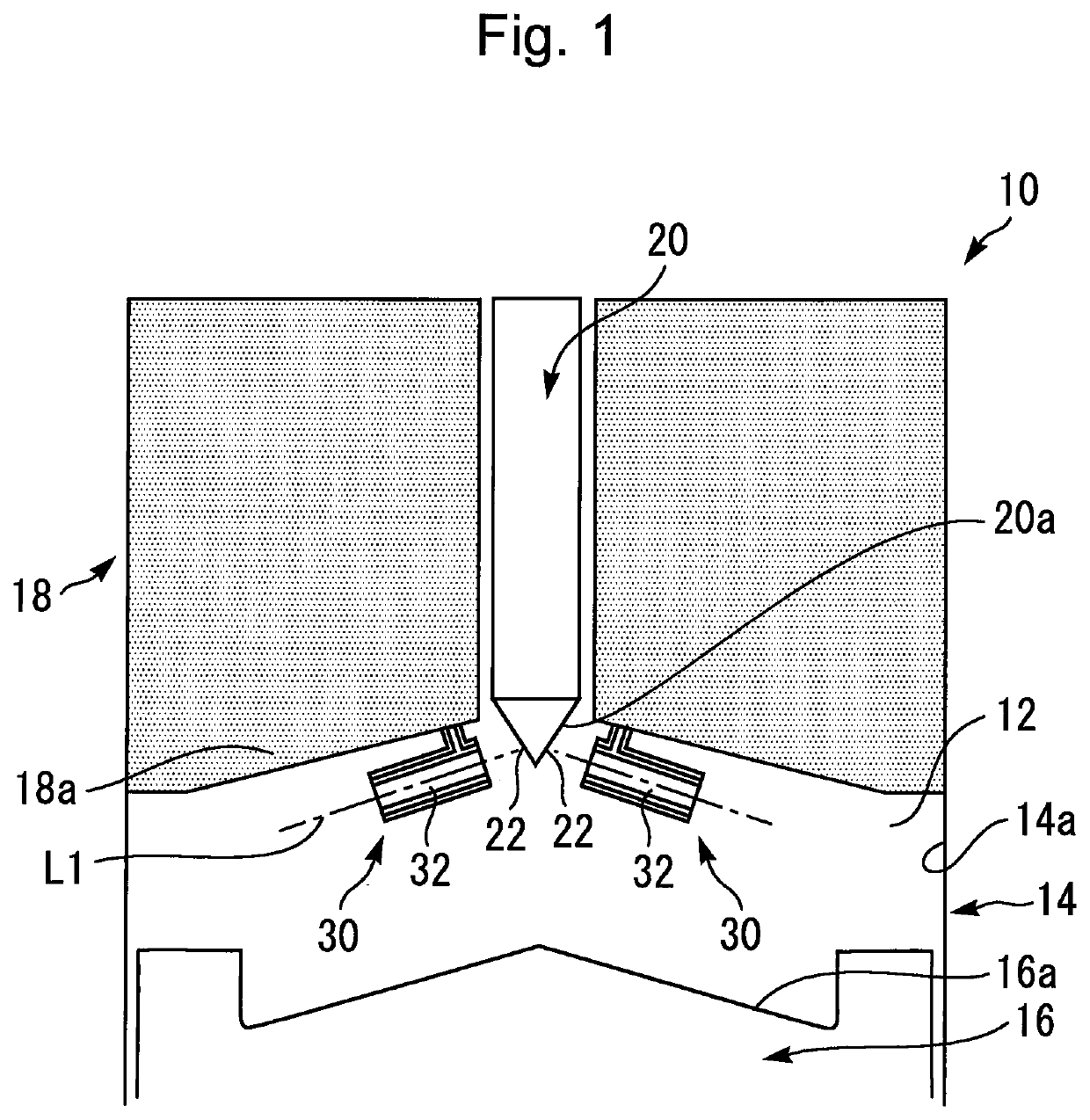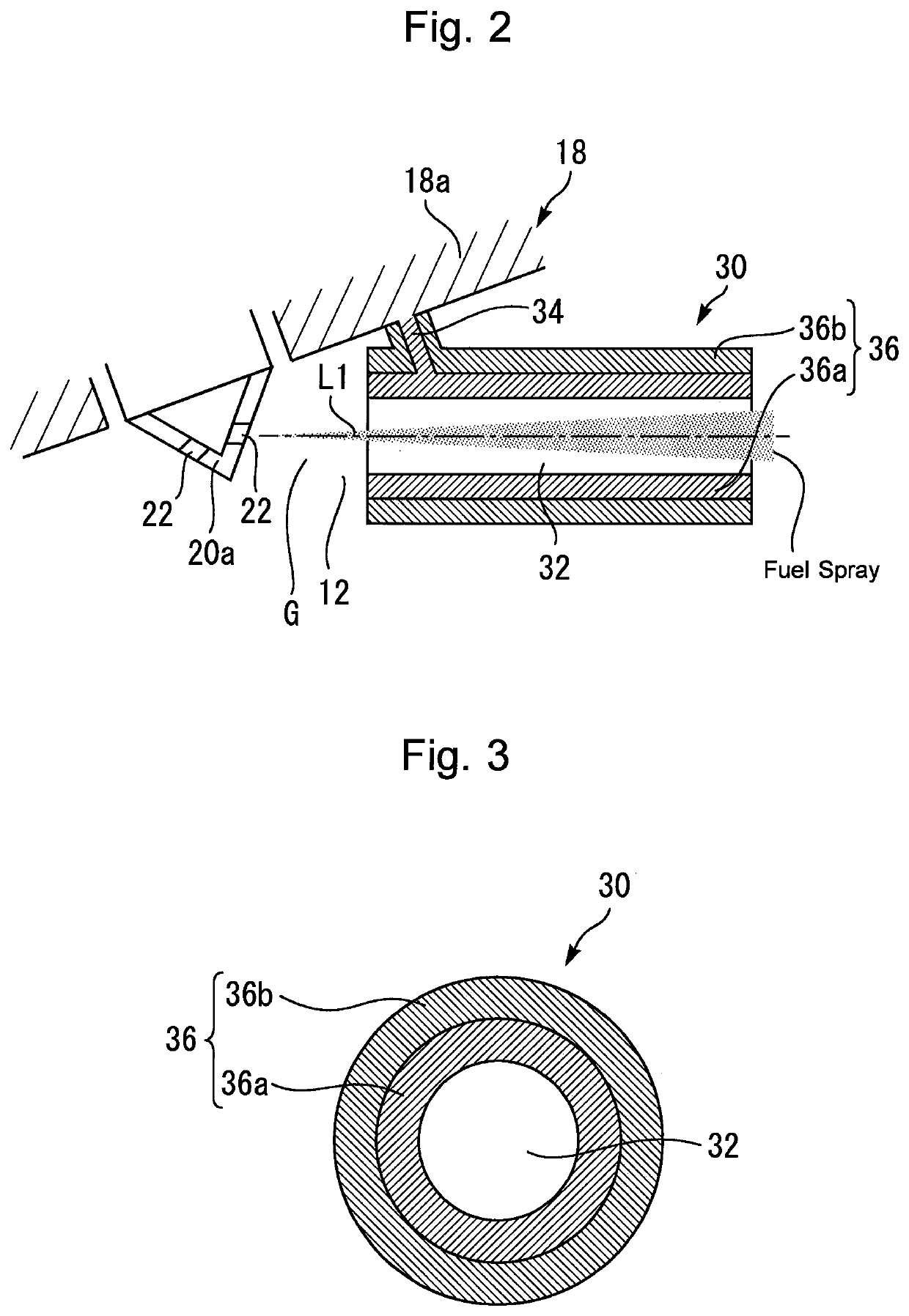Compression-ignition internal combustion engine
a technology of compression ignition and internal combustion engine, which is applied in the direction of machines/engines, combustion-air/fuel-air treatment, electric control, etc., can solve the problem of higher temperature of the duct, and achieve the effect of favorable reduction of the wall surface temperature of the flow guide passage, easy maintenance over a long time, and enhanced shape retention of the passage wall portion
- Summary
- Abstract
- Description
- Claims
- Application Information
AI Technical Summary
Benefits of technology
Problems solved by technology
Method used
Image
Examples
first embodiment
1. First Embodiment
[0035]A first embodiment according to the present disclosure and modification examples thereof will be described with reference to FIGS. 1 to 5.
1-1. Configuration In and Around Combustion Chamber
[0036]FIG. 1 is a longitudinal sectional view that schematically illustrates the configuration in and around a combustion chamber 12 of a compression-ignition internal combustion engine (hereunder, simply abbreviated as an “internal combustion engine”) 10 according to the first embodiment of the present disclosure. As an example, the internal combustion engine 10 shown in FIG. 1 is a diesel engine.
[0037]As shown in FIG. 1, the internal combustion engine 10 is provided with a cylinder block 14, pistons 16 and a cylinder head 18. The pistons 16 reciprocate inside the respective cylinders formed in the cylinder block 14. The cylinder head 18 is arranged on the cylinder block 14. The combustion chamber 12 is mainly defined by a cylinder bore surface 14a of the cylinder block 1...
modification examples concerning first embodiment
1-3. Modification Examples Concerning First Embodiment
1-3-1. Another Example of Double-Layered Structure for Duct
[0056]FIG. 4 is a schematic diagram for describing another example of the configuration of the first and second layers of the passage wall portion. It should be noted that FIG. 4 shows only one of ducts 40, and this also applies to FIGS. 5 to 7. According to the example shown in FIG. 4, a duct 40 (i.e., passage forming member) includes a passage wall portion 42 along with the support portion 34. The passage wall portion 42 includes a first layer 42a and a second layer 42b located radially outward of the first layer 42a.
[0057]According to the example of the duct 30 shown in FIG. 2, the first layer 36a is formed so as to extend over the whole passage wall portion 36 in the longitudinal direction of the flow guide passage 32, and the second layer 36b is formed so as to cover the whole first layer 36a. In contrast to this, according to the example of the duct 40 shown in FIG...
second embodiment
2. Second Embodiment
[0061]Then, a second embodiment according to the present disclosure will be described with reference to FIG. 6.
2-1. Difference from First Embodiment
[0062]FIG. 6 is a schematic diagram for describing the configuration of a duct 60 according to the second embodiment of the present disclosure. An internal combustion engine according to the present embodiment is different, in the following points, from the internal combustion engine 10 according to the first embodiment.
[0063]The duct 60 shown in FIG. 6 includes a passage wall portion 62 along with the support portion 34. The passage wall portion 62 includes a first layer 62a and a second layer 62b. The shape and material of the first layer 62a is the same as those of the first layer 36a shown in FIG. 2. On the other hand, the second layer 62b has the same shape as the second layer 36b shown in FIG. 2 but the second layer 62b and the second layer 36b are different in material as described below.
[0064]More specifically...
PUM
 Login to View More
Login to View More Abstract
Description
Claims
Application Information
 Login to View More
Login to View More - R&D
- Intellectual Property
- Life Sciences
- Materials
- Tech Scout
- Unparalleled Data Quality
- Higher Quality Content
- 60% Fewer Hallucinations
Browse by: Latest US Patents, China's latest patents, Technical Efficacy Thesaurus, Application Domain, Technology Topic, Popular Technical Reports.
© 2025 PatSnap. All rights reserved.Legal|Privacy policy|Modern Slavery Act Transparency Statement|Sitemap|About US| Contact US: help@patsnap.com



